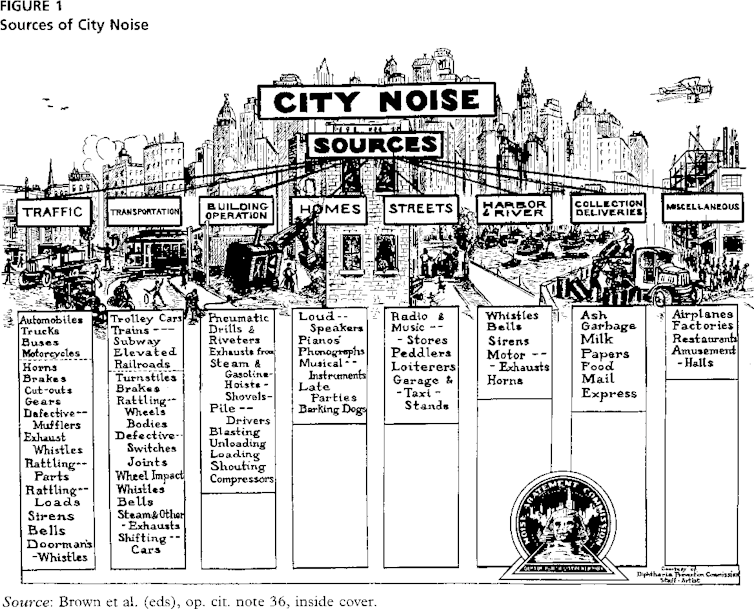On a Friday, in late February, during rush-hour in Truro, N.S., I recorded 80 seconds of noise dynamics at a four-way intersection. I returned on April 3 after the COVID-19 restrictions sent people in Canada indoors. More than just looking empty, Canada may also be quieter.
Canadian towns and cities are experiencing a significant decrease in their social, recreational, industrial and economic activities due to the protocols required to address COVID-19.
In our urban cities, audio data is more comprehensive than its visual counterpart; noise can be detected from kilometres away and emanates from hidden buildings. Humans are the dominant sound makers in most landscapes — from machinery to cars to simply being about.
Read more: Where the wild things are: how nature might respond as coronavirus keeps humans indoors
In February, before the pandemic brought about a large-scale societal change, I recorded audio levels of urban and nature sounds in Truro. Compared with recordings taken again in April, acoustical analyses showed a distinct decrease in urban sound signatures and an increase in natural sounds.
Urban soundscapes
Noise has been a concern of city dwellers since Roman times, when a law prohibited the driving of chariots through the cobblestone streets of Rome at night. As cities modernized and industrialized, excessive noise was the foremost “quality of life” complaint in New York City.

Sound is measured in decibels (dB), which reflect the intensity of noise; decibels indicate the relative loudness of sounds. Each 10 dB increase corresponds to roughly a doubling of the average loudness, or noisiness, of the acoustic environment.
Almost everything makes a measurable noise. Standard breathing is 10 dB and normal conversation is 60 dB. Louder noises like a chainsaw are measured at 110 db, while an ambulance siren is 120 dB and a rocket launch is a whopping 180 dB. The World Health Organization has stated that regular and prolonged exposure to noise at 85 dB (cars and trucks) and higher is considered hazardous; even hearing something that measures 100 dB (some construction and manufacturing) for just 15 minutes a day can lead to permanent hearing loss.
As more sounds fill our environments, however, important sounds must become louder. For example, the sound output of the police siren has risen 40 dB in many North American cities as a result of more traffic, additional street activity and an overall increased ambient sound level. An ambulance, fire or police siren needs to be one of the highest levels of city sounds.
Many large cities such as Vancouver and Toronto have strict noise control plans to ensure public health and safety.

Conversely, natural sounds such as that of water, birds, animals and the changing environment are often considered more pleasurable than those within over-saturated urban environments. Acoustic ecology, a discipline founded by R. Murray Schafer and his team at Simon Fraser University, seeks “to find solutions for an ecologically balanced soundscape where the relationship between the human community and its sonic environment is in harmony.”
A consumer market exists for natural soundscapes and other stress-relieving noises. Natural sounds have a strong connection to conservation and the importance of ecological awareness. In 1949, Québecois biologists were the first to record the sounds of marine mammals to promote conservation and awareness. The new and evolving field of ecoacoustics (or bioacoustics) is already changing how researchers assess ecosystem health and evaluate human impact.
As part of the Green Infrastructure Performance Lab at Dalhousie University, I study the differences between urban and rural landscapes, and investigate the changes that occur through urbanization and human development.
The sounds I recorded fall in to five groups and general decibel ranges:
- Nature (10-50 dB): lower level noises like rustling leaves, wind and rainfall.
- Humans (60-85 dB): noise from socio-cultural actions like sports, talking, tv/radio/phone, small tool use and more.
- Urban life (65-95 dB): sounds from urbanized areas like sirens, footsteps, bicycles, ships, airplanes and dogs barking.
- Vehicles (70-95 dB): sounds from road transport can indicate engine type, vehicle density and rate and the presence of paved road.
- Work (75-100 dB): noise from construction, manufacturing, agriculture, industry and other human economic activities.
In my early findings, in February, it was common to hear the sounds of vehicles and urban life — planes, cars, footsteps, barking dogs and others — sounds typically within the 60-100 dB range.
But in April, recordings at the same location revealed the nature noises that were no longer masked by the louder sounds of human activity: rustling leaves, wind, streams and birds — sounds of nature below the 50 dB level.
The sounds of nature are important to our well-being
There is an urban rhythm to city soundscapes. Studies conclude this urban background noise is comforting to some. Regardless, there are neurobiological mechanisms operating our physiological and psychological reactions to natural noise stimuli. Natural sounds have the capacity to sooth and impact us the ways urban sounds cannot. This is considered biophilia, or our genetic predisposition towards all things within nature.
Noise levels have an impact on health. Much of the research on the benefits of natural sounds point to Attentional Restoration theory and Stress Recovery theory, which assert the body and brain’s ability to recover from fatigue or passively recharge itself.
The human well-being advantages of bioacoustics or listening to natural sounds are many and include reduced heart rate, reduced levels of stress and anxiety, increased positive emotions, overall wellbeing and increased productivity.
Urban lifestyles are often disconnected from the natural environment; hearing the sounds of nature can be rare for city residents. However, those sounds are there, just overshadowed by human noise.
Go out on the porch or deck, listen to the nature in your neighbourhood — you might even hear silence — it won’t last.
"hear" - Google News
May 06, 2020 at 02:34AM
https://ift.tt/3c3j4aq
How COVID-19 shutdowns are allowing us to hear more of nature - The Conversation CA
"hear" - Google News
https://ift.tt/2KTiH6k
https://ift.tt/2Wh3f9n
Bagikan Berita Ini














0 Response to "How COVID-19 shutdowns are allowing us to hear more of nature - The Conversation CA"
Post a Comment